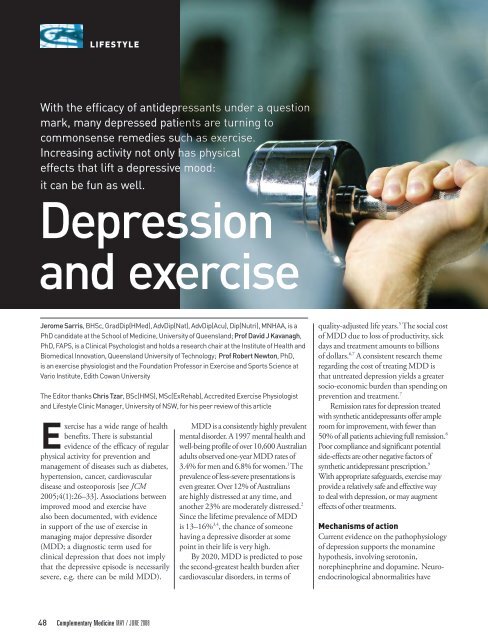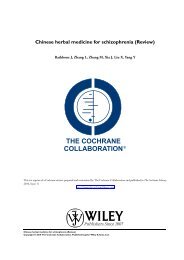Depression and exercise - Informit
Depression and exercise - Informit
Depression and exercise - Informit
You also want an ePaper? Increase the reach of your titles
YUMPU automatically turns print PDFs into web optimized ePapers that Google loves.
<strong>Depression</strong> <strong>and</strong> <strong>exercise</strong> lifestyle• Regular <strong>exercise</strong> improves mood<strong>and</strong> helps to relieve depression• Exercise increases BDNF,b–endorphins, regulates HPTAaxis <strong>and</strong> 5HT, decreases cortisol,increases testosterone <strong>and</strong> growthhormone• Higher intensity anabolic <strong>and</strong>perhaps aerobic training appear tohave greater antidepressant effects• Exercise programmes should betailored to the individual’s needsalso been documented. Hyperactivity ofHPTA axis <strong>and</strong> increased serum cortisolreduces brain-derived neurotrophicfactor, reducing neurogenesis. 10,11 Otherbiological factors may include impairedendogenous opioid function, abnormalcircadian rhythm, changes in GABAergic<strong>and</strong>/or glutamatergic transmission, <strong>and</strong>cytokine <strong>and</strong> steroidal alterations. 10,11Various potentially antidepressantneurochemical responses are knownto occur as a result of <strong>exercise</strong>. Animalmodels have demonstrated that <strong>exercise</strong>increases brain-derived neurotrophic factor,promoting neurogenesis. 12 Human studieshave documented an increase in circulatingb–endorphins after acute <strong>exercise</strong>,promoting mood elevation, increased painthreshold <strong>and</strong> neurogenesis. 13Modulation of the HPTA axis alsooccurs with physical activity. Exercise canproduce an acute increase in cortisol if theoverload is excessive <strong>and</strong>/or appropriatenutritional intake does not accompany the<strong>exercise</strong> session. However, long-term effectsof regular <strong>exercise</strong> may assist in regulatingthe HPTA axis <strong>and</strong> produce a chronicreduction in cortisol production. Increasedexpression of 5HT in the cerebral cortexof rats has been observed as a result of<strong>exercise</strong> <strong>and</strong> this is theorised to explainmuch of the antidepressant effect ofphysical activity. 14Further, certain modes of <strong>exercise</strong> havebeen demonstrated to markedly increasecirculating levels of testosterone in bothmen <strong>and</strong> women, which may also havea protective effect against depression. 15In addition, <strong>exercise</strong> causes the musclesto bind stress chemicals such asadrenaline, effectively neutralising theirpsychological impact <strong>and</strong> producing amore relaxed state of mind.There are also psychological factors thatmay contribute to positive effects of <strong>exercise</strong>on depression. Exercise is often a pleasurableactivity, <strong>and</strong> pleasant activities have longbeen known to lift depressive mood. 16Exercise in groups or sporting teamsprovides social interaction that may also bepleasurable <strong>and</strong> also provide opportunitiesfor practical <strong>and</strong> emotional support.Further advantages of <strong>exercise</strong> arethat it avoids attracting social stigma— a significant barrier to treatmentseeking — <strong>and</strong> is highly accessible,regardless of location.These features may help to address therelatively low rate of uptake for depressiontreatment in Australia. 2Current evidenceLarge cross-sectional studies showassociations between greater physicalactivity <strong>and</strong> improved mood <strong>and</strong>well-being 17 <strong>and</strong> several RCTs confirmits efficacy in managing MDD.An earlier meta-analysis of 11treatment-outcome studies of <strong>exercise</strong>on the treatment of depression 16revealed a significant effect in favourof physical <strong>exercise</strong> compared withcontrol conditions (wait list, routinecare, meditation/relaxation or low-level<strong>exercise</strong>). A very large average effect sizewas obtained (95% CI: 0.92–1.93),with all but two studies obtaining betterresults from <strong>exercise</strong> than from control.However, many of these studies hadsignificant methodological weaknesses. 17An example of a recent high-qualitytrial is a four-arm RCT, involving 202adults with diagnosed MDD, thatcompared aerobic <strong>exercise</strong> (supervised orin the home environment) to sertraline(Zoloft) <strong>and</strong> placebo. 18 Supervised <strong>exercise</strong>was comparable to sertraline, with 45 percent <strong>and</strong> 47% of participants respectivelyachieving remission after four months. Theplacebo arm had 31% remission, whilehome-based <strong>exercise</strong> had 40%. However,the difference between the treatments felljust short of statistical significance.A 2006 Cochrane review of <strong>exercise</strong> ina child <strong>and</strong> adolescent population (up toage 20) 19 found only one study that usedit for treatment of depression. That studydid not find any significantly differenteffect from aerobic <strong>exercise</strong> compared withno treatment. Five depression-preventionor general-population studies did obtaina differential effect from aerobic <strong>exercise</strong>or weight training on depressive mood,but that effect was small (–0.66, 95% CI:–1.25 to –0.08) <strong>and</strong> heterogeneous acrossthe studies. Overall, the methodologicalquality of studies was poor.In treating postpartum depression,the limited available evidence supportsphysical activity <strong>and</strong> <strong>exercise</strong> injanuary may / february / june 2008 Complementary Medicine49
lifestyle <strong>Depression</strong> <strong>and</strong> <strong>exercise</strong>reducing depressive symptoms. 20 TwoAustralian pilot studies have evaluatedthe antidepressant effect of grouppram walking against control (normalactivity <strong>and</strong> social support). 20 Significantdifferences between groups wereobtained, with the pram walkers havinga substantial reduction on the EdinburghPostnatal <strong>Depression</strong> Scale compared tocontrol (P50% indepressive symptoms was achieved in 61%of the higher-intensity group, comparedto 29% low-intensity group, <strong>and</strong> 21%of routine GP-care group (P=0.03).Interestingly, strength gain was directlyassociated with a reduction of depressivesymptoms. That is, those patientswho exhibited the greatest strengthimprovement from training produced the50Complementary Medicine may / june 2008
<strong>Depression</strong> <strong>and</strong> <strong>exercise</strong> lifestyleAre your PatientsRunning outof Steam?best improvement in depression scores.On current evidence, recommendationsfor <strong>exercise</strong> mode <strong>and</strong> dosage for themanagement of clinical depression favouranabolic over aerobic <strong>exercise</strong>. The intensityneeds to moderate to high <strong>and</strong> performed2–3 times per week. Aerobic <strong>exercise</strong> alsoappears beneficial, <strong>and</strong> should be includedas part of an overall physically activelifestyle. The American College of SportsMedicine, in partnership with the AmericanHeart Associate, has just released updatedrecommendations for <strong>exercise</strong> for adults <strong>and</strong>older adults [see box, p 50].YogaThere is also some evidence in support ofyoga as a mood-enhancing intervention.A review by Pilkington et al located fiveRCTs using various types of yoga to treatMDD. 25 While the studies reviewed allconcluded positive results, the studieswere poorly reported. It is worthwhilehighlighting that certain types of yoga mayactually have greater antidepressant effect.In line with previous studies demonstratingthat ‘stretching’ has a placebo effect,higher-intensity yoga with emphasis on‘mindfulness’ potentially will have greaterefficacy than low-intensity, low-focus yoga.Tai chiTraditional Chinese medicine (TCM)recognises <strong>and</strong> promotes the use of <strong>exercise</strong>to address depressive conditions. <strong>Depression</strong>in Chinese is called yiyu, referring to ‘Yusyndrome’ that translates as ‘not flowing,entangled or clogged’. 26 Two primarypatterns of depression are diagnosed inTCM: ‘stagnation of liver qi’ (excess pattern)<strong>and</strong> ‘deficiency of qi, blood or kidney jing’(deficient pattern). 27In principle, physical activity <strong>and</strong><strong>exercise</strong> are regarded to ‘move qi <strong>and</strong> blood’,so alleviating ‘stagnation’, <strong>and</strong> to ‘tonifyqi’ (lung <strong>and</strong> spleen), thereby improvingenergy <strong>and</strong> vigour. Excessive or intensiveactivity would however be contraindicatedin patterns of marked deficiency, hencelighter <strong>exercise</strong>, such as tai chi, would becommonly recommended in such cases togently build vitality. A small study 28 in anolder group of people with depression ordysthymia obtained significantly greaterreductions in self-reported depressioncompared with a wait-list control. Somelarger-scale trials using tai chi are needed toclarify its impact on clinical depression.Exercise prescriptionsCaveats exist regarding <strong>exercise</strong> prescriptionfor MDD. <strong>Depression</strong> may be worsened ifthe person is unable to meet expectations,potentially promoting a sense of failure<strong>and</strong> guilt. This may be more likely tooccur in severe MDD, especially wherepsychomotor retardation, hypersomnia,somnilescence, marked fatigue oranhedonia are present. Patients shouldbe screened for comorbidities, includingcardiovascular disease or musculoskeletalconditions, prior to initiating an <strong>exercise</strong>regime. In these cases, an appropriatephysiological examination before starting aprogram is strongly recommended, <strong>and</strong> anappropriate allied health professional, e.g.<strong>exercise</strong> physiologist, should be involved inthe design <strong>and</strong> monitoring of the program.Patients referred by their GP to accredited<strong>exercise</strong> physiologists may claim a Medicarerebate for up to five sessions per year.Supervision of the <strong>exercise</strong> mayheighten adherence <strong>and</strong> <strong>exercise</strong>that is social <strong>and</strong> highly pleasurablemay have augmented impact. Many<strong>exercise</strong> modalities are available <strong>and</strong>the option/s should be tailored to suitthe individual, taking into accountthe severity of the depression, age,body type, comorbidities <strong>and</strong> theavailability of equipment, facilities<strong>and</strong> <strong>exercise</strong> specialists. If <strong>exercise</strong> is toprovide sustained psychological <strong>and</strong>physiological benefits, it needs to bemaintained by being incorporated intothe person’s routine <strong>and</strong> lifestyle.continued on page 62let’s get theirenergy back!AS YOU KNOW, IRON IS SO DIFFICULT FOR THEBODY TO ABSORB SO THAT’S WHERE FLORADIXHERBAL IRON EXTRACT CAN BE OF ASSISTANCE.Floradix contains a source of iron balanced witha range of B Vitamins <strong>and</strong> Vitamin C as well asother nutri-rich herbs. Taken twice daily, Floradixcan assist in the maintenance of general healthfor the whole family, from young childrento expectant mothers <strong>and</strong> elderly people.Floradix is a special liquid formula that:• Contains iron in a soluble form• Contains no artificial colouring or preservatives• Is free of alcohol• Contains natural herbal extracts high in anti-oxidants• Contains Vitamin C• Contains Vitamins B1, B2, B6 <strong>and</strong> B12Floradix has been used worldwidefor over 60 years - improvingwomen’s energy <strong>and</strong> healthAVAILABLE AT ALL GOOD HEALTH STORES,SELECTED PHARMACIES AND COLESEnquiries, Nature’s Synergy Pty LtdPhone (02) 9499 7023 Fax (02) 9499 7024
holistic casebook post-miinsecurity levels. On questioning,it appeared that he was becomingincreasingly depressed. He stayed athome ‘brooding’ about the futurebut was also extremely unmotivated<strong>and</strong> had become socially withdrawn.He was fearful of his financial futurebut was not taking any of the stepsnecessary to try <strong>and</strong> find a new job.Using a mental-health measurementtool, the DM1-10, he had a score of30 (the maximum possible) <strong>and</strong> wasprescribed Zoloft but, after consideration,he declined this medicine.The mental-health issues seennow were in many ways just a morepronounced version of his usualanxious depression seen over the years<strong>and</strong>, as before, it was complementaryto his poor lifestyle choices.However, he now seemed at a pivotaljuncture in his life in that he had theopportunity to act on the ‘wake-up call’<strong>and</strong> proactively change his life behaviours<strong>and</strong> habits. However, his tendencyto mope <strong>and</strong> slide into a ‘vegetative’depression were concerning. Thenormal adjustment phase to his changedhealth <strong>and</strong> circumstances were rapidlybecoming a new baseline state for himfrom which positive changes wereunlikely, <strong>and</strong> continued unemployment<strong>and</strong> further mental health issues <strong>and</strong>cardiac events would be more likely.A stress echocardiogram revealedexcellent <strong>exercise</strong> capacity, withpost-<strong>exercise</strong> echo indicating mildischaemia <strong>and</strong> hypokinesis in thepostero-lateral area, consistent with theknown circumlex obstruction.ConclusionA thorough assessment of Victor’sactive biochemistry risk factorsreveals hyperlipidaemia but no othersignificant abnormalities. However,analysis of his lifestyle risk factorsreveals issues relating to diet, smoking,stress management, anxiety <strong>and</strong>depression, so a health managementplan was organised [see p 60]. ◗HOLISTIC CASEBOOKcontinued from page 56lifestylecontinued from page 53Follow-upIt has been almost 12 months since Verabegan using the products mentioned, <strong>and</strong>still uses two capsules of the fish oil butone each of the eye-health supplements.Her optometrist has seen her again,<strong>and</strong> she is also under the care of anophthalmologist. Both professionalsare impressed that she has managed toincorporate a routine of supplementsthat is easy to maintain long term. Bothhealthcare providers <strong>and</strong> their patient arelooking forward to a bright future. ◗References1 SanGiovanni JP, et al. Arch Opthalmol2007;125(5):671–9.2 National Eye Institute. AREDS Results. URLwww.nei.nih.gov/amd/background.asp.3 Mares JA, et al. Am J Clin Nutr2006;84:1107–22.4 Tan JSL, et al. Ophthalmol 2008;115:334–41.5 O’Connell ED, et al. Am J Clin Nutr2008;87(3):712–22.6 Tan JS, et al. Br J Ophthalmol 2008;92:509–12.7 Cohen SY. Bull Soc Belgian Opthalmolog2006;(301):33–6.8 Jellin JM. Natural Medicines ComprehensiveDatabase. URL www.naturaldatabase.com/.References1 McLennan W. Mental health <strong>and</strong> wellbeing. Canberra: Australian Bureau of Statistics, 1997.2 Andrews G. Brit J Psychiat 2001;178:145–53.3 Alonso J, et al. Acta Psychiatr Sc<strong>and</strong> Suppl 2004;420(420):21–7.4 Kessler RC, et al. J Am Med Assoc 2003;289(23):3095–105.5 Murray CJ, et al. Lancet 1997;349(9064): 1498–504.6 Kessler RC, et al. Am J Psychiatr 2006;163(9): 1561–8.7 Donohue J, et al. Pharmacoecon 2007;25(1): 7–24.8 Berton O, et al. Nat Rev Neurosci 2006;7(2):137–51.9 Arroll B, et al. Ann Fam Med 2005;3:449–56.10 Belmaker RH, et al. NEJM 2008;358:55–68.11 Hindmarch I. Hum Psychopharmacol 2001; 16(3):203–18.12 Duman R. Neurobiol Aging 2005;26S:S88–S93.13 Bender T, et al. Europ J Appl Physiol 2007;100(4):371–82.14 Dey S, et al. Physiol Behav 1992;52:1095–9.15 McIntyre RS. Psychoneuroendocrinol 2006;31:1029–35.16 Zeiss A. J Consult Clin Psychol 1979;47:427–39.17 Brosse AL, et al. Sports Med 2002;32:741–60.18 Blumenthal JA, et al. Psychosom Med 2007;69(7):587–96.19 Larun L, et al. Cochrane Database of Systematic Reviews, 2007(4).20 Daley AJ, et al. J Midwif Women’s Health 2007;52(1):56–62.21 Sjosten N, et al. Int J Geriatr Psychiatr 2006; 21(5):410–8.22 Doyne EJ, et al. J Consult Clin Psychol 1987; 55(5):748–54.23 Dunn AL, et al. Am J Prevent Med 2005 28(1):1–8.24 Singh NA, et al. J Gerontol Series A: Biolog Sci Med Sci 2005;60A(6):768–76.25 Pilkington K, et al. J Affect Disord 2005;89:13–24.26 Ng S, et al. Brit J Social Work 2006;36(3): 467–84.27 Maciocia G. The Practice of Chinese Medicine. London: Churchill Livingstone, 1994.28 Chou K-L. Internat J Geriatr Psychiat 2004;19(11):1105–07.62 Complementary Medicine may / june 2008



